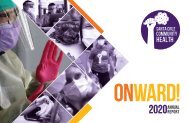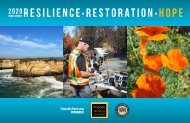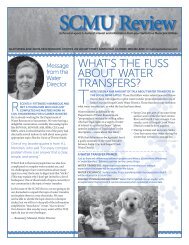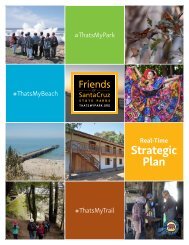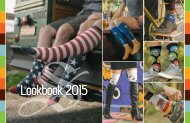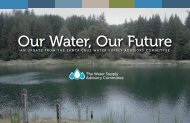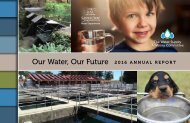You also want an ePaper? Increase the reach of your titles
YUMPU automatically turns print PDFs into web optimized ePapers that Google loves.
Our Water,<br />
Our Future<br />
ANNUAL REPORT<br />
<strong>2017</strong>
Dear Resident,<br />
It’s been two years since the Santa Cruz City Council approved recommendations<br />
made by the Water Supply Advisory Committee (<strong>WSAC</strong>) to help make our water<br />
supply secure and reliable. This second <strong>Annual</strong> <strong>Report</strong> will bring you up to speed<br />
on the status of those recommendations.<br />
First a quick recap. The <strong>WSAC</strong> – a group of 14 residents who were appointed by<br />
the City Council in 2014 – met for 18 months to complete a deep technical dive<br />
into the City’s water system. The <strong>WSAC</strong> identified the water supply gap that<br />
needs to be filled, and made several recommendations for potential solutions.<br />
The <strong>WSAC</strong> finished their work by making the following recommendations<br />
to City Council:<br />
• Increase water conservation<br />
• Explore sharing water with other water districts<br />
• Store excess winter water in underground aquifers<br />
• Utilize purified recycled water<br />
• Utilize desalinated water to meet the supply gap<br />
The <strong>WSAC</strong> also recommended that the City study the feasibility of all five<br />
recommendations at the same time, so that by 2020 a fully informed decision<br />
can be made on which recommendation(s) to implement.<br />
That brings us to 2018. What’s happened since our last report?<br />
Sincerely,<br />
Rosemary Menard, Water Director, Santa Cruz Water Department
Conservation<br />
Customer water use continued to trend lower in <strong>2017</strong>,<br />
despite abundant rainfall.<br />
In <strong>2017</strong>, we:<br />
• Implemented a new water rate structure that<br />
encourages conservation<br />
• Doubled the number of workshops and trainings<br />
we provided for the public and partnered with<br />
other utilities<br />
• Improved the large landscape water budget<br />
program by providing hourly consumption<br />
data online<br />
• Designed and implemented a pilot project to assess<br />
the feasibility of Advanced Metering Infrastructure<br />
for large landscapes, parks and school sites<br />
• Produced and distributed an award-winning<br />
Know Your Water Service guidebook to encourage<br />
efficient water use<br />
• Reached a milestone of 10,000 plumbing retrofits<br />
on resale properties since our retrofit program<br />
began in 2003<br />
• Became the first utility in the nation to earn<br />
Platinum Status for water conservation program<br />
operations and management from the Alliance<br />
for Water Efficiency
Aquifer Storage and Recovery<br />
In <strong>2017</strong>, we made significant progress on Aquifer Storage<br />
and Recovery (ASR), completing critical analyses to determine<br />
the technical feasibility, as well as a study to identify potential<br />
sites for future wells to inject and recover water that would be<br />
stored in regional aquifers.<br />
The most significant finding of the feasibility analyses is that<br />
there does not appear to be a “fatal flaw,” on paper, with<br />
the concept.<br />
ASR:<br />
DID YOU KNOW?<br />
The same well<br />
can be used to both inject<br />
surface water into an aquifer,<br />
and also to withdraw<br />
from it? Not so with<br />
recycled water.<br />
What kinds of things could prevent ASR? For example, negative<br />
results from a study of whether adding surface water to<br />
groundwater produces poor water quality. Or, whether<br />
injection and recovery rates will be within the parameters<br />
needed to cost-effectively build and operate the project.<br />
So far, none of these fatal flaws have been identified.<br />
Up to an acre of land can be required for new wells, pumps,<br />
treatment and maintenance. Also, the well must be located<br />
where water can be injected into the water-bearing strata<br />
of an aquifer, and new wells can’t be placed too close to<br />
existing wells.
Water Exchange/Water Sharing<br />
In <strong>2017</strong>, a Memorandum of Agreement was signed with the<br />
Scotts Valley Water District, San Lorenzo Valley Water District<br />
and Santa Cruz County to evaluate potential opportunities for<br />
conjunctive use of surface and groundwater resources.<br />
Ninety-five percent of Santa Cruz’s water supply is surface<br />
water (creeks and rivers) and Soquel Creek and Scotts Valley<br />
water supplies are 100% groundwater from aquifers. San<br />
Lorenzo Valley water supply is a combination of surface<br />
water and groundwater. The chemistry of surface water and<br />
groundwater is different, and may require different treatment.<br />
In <strong>2017</strong>, in-depth analyses began to study the compatibility of<br />
using surface water in a groundwater system, and vice versa.<br />
In particular, the studies are looking at the potential for the<br />
release of lead, copper or iron that may exist in household<br />
plumbing, which could be triggered by switching source<br />
water sources. Results of the analysis will determine the future<br />
course for water sharing with other districts.<br />
WATER EXCHANGE:<br />
DID YOU KNOW?<br />
Conjunctive use<br />
means to use groundwater and<br />
surface water synergistically.<br />
5
Recycled Water and Desal<br />
During an 18-month study that began in 2016, we looked at more than<br />
40 options for using advanced-treated wastewater from the City’s<br />
Wastewater Treatment Facility as a potential supplemental water supply.<br />
We also updated the existing desalination project assumptions and cost<br />
estimates so that we could evaluate both back-up options – recycled water<br />
and desalination – with current information.<br />
RECYCLED WATER: DID YOU KNOW?<br />
The City of Santa Cruz Wastewater<br />
Treatment Facility serves<br />
130,000 people<br />
and discharges ±six million gallons<br />
of treated wastewater into<br />
the bay every day.
Treated recycled water has many uses, and we looked at several of<br />
them during the past year. From irrigation, to being pumped up to and<br />
blended with water stored in the Loch Lomond Reservoir, to being<br />
treated and injected into aquifers, the results of the analyses have<br />
created a rich data source for comparison of all of the alternatives<br />
for a final recommendation.<br />
DESAL: DID YOU KNOW?<br />
The Ocean Plan<br />
was amended in 2015 with a specific<br />
approach to design and operate new<br />
and expanded desalination facilities<br />
that minimize ocean impacts.<br />
Using the existing desalination project framework, we incorporated<br />
comments made in the 2013 project Environmental Impact <strong>Report</strong>,<br />
along with new environmental regulations and direction from the<br />
<strong>WSAC</strong>, to update the desalination project scope. Based on the amount<br />
of water the <strong>WSAC</strong> determined is needed to fill our supply gap during<br />
dry years, the updated scope reflects a bigger desal project as well as<br />
adjusted intake and pump station locations.
Upcoming Meetings<br />
The Water Commission meets on the first Monday<br />
of every month and the public is encouraged to<br />
attend. Meetings are at 7 pm and are typically held<br />
in City Council Chambers at 809 Center Street.<br />
Visit cityofsantacruz.com/government/citydepartments/water/city-water-commission<br />
to<br />
confirm the location and preview the agenda.<br />
A joint meeting of the Water Commission and the City<br />
Council will be held on April 10 to update the Council<br />
on progress made on the <strong>WSAC</strong> recommendations. The<br />
meeting will be at 7 pm in the City Council Chambers –<br />
809 Center Street.<br />
Sign up to receive the monthly <strong>WSAC</strong> update email<br />
at santacruzwatersupply.com.<br />
212 Locust Street<br />
Santa Cruz, CA 95060<br />
PRSRT STD<br />
US POSTAGE<br />
PAID<br />
SANTA CRUZ, CA<br />
PERMIT NO. 11





